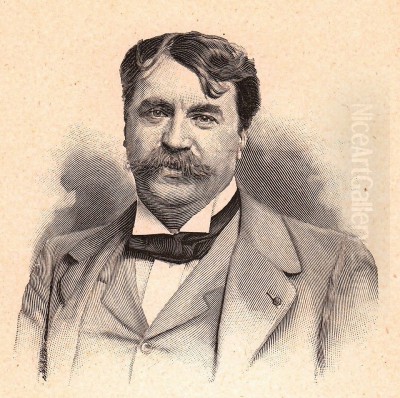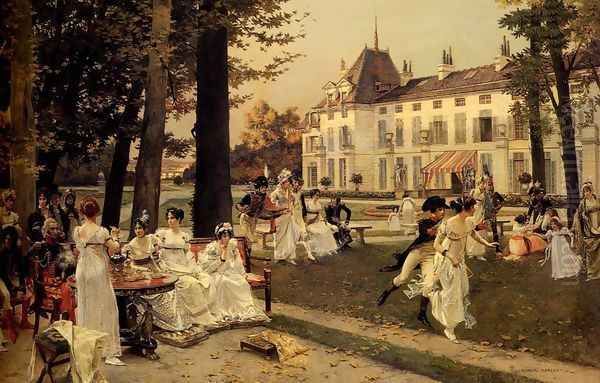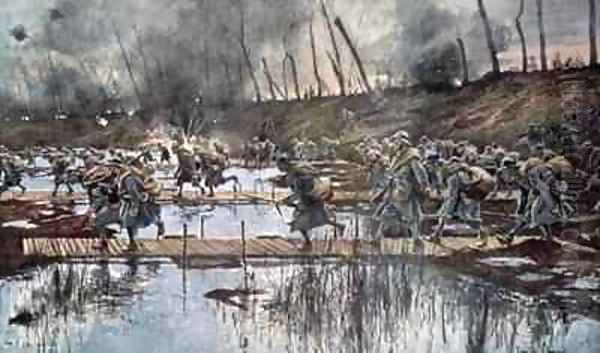
François Flameng stands as a significant figure in French art during the late nineteenth and early twentieth centuries. Born in Paris on December 6, 1856, and passing away in the same city on February 28, 1923, Flameng navigated the vibrant and often tumultuous art world of the French Third Republic. He achieved considerable fame during his lifetime as a painter of historical scenes, a sought-after portraitist for high society, and later, an official artist documenting the realities of World War I. His work, rooted in the academic tradition, reflects both the technical mastery prized by the establishment and an awareness of contemporary artistic currents.
Flameng's journey as an artist was deeply influenced by his background. He was the son of Léopold Flameng, a highly respected and successful engraver and etcher. This familial connection provided young François with an early immersion in the visual arts and likely facilitated access to artistic circles and training. Growing up in Paris, the undisputed center of the Western art world at the time, further nurtured his burgeoning talent. He received a first-rate formal art education, a crucial step for any aspiring painter aiming for official recognition and success within the established Salon system.
Early Life and Artistic Formation
François Flameng's artistic education was solidified at the prestigious École des Beaux-Arts in Paris. This institution was the bastion of academic art training in France, emphasizing rigorous drawing skills, the study of classical antiquity and Renaissance masters, and the hierarchy of genres, which placed history painting at the apex. Within its demanding environment, Flameng honed his craft under the tutelage of influential academic painters.
Among his most notable teachers was Alexandre Cabanel. Cabanel was a dominant figure in the French art establishment, renowned for his mythological and historical paintings, as well as his elegant portraits. He epitomized the polished, idealized style favored by the Academy and the official Salon juries. Studying with Cabanel undoubtedly instilled in Flameng a strong foundation in academic draftsmanship, composition, and the smooth, refined finish characteristic of much official art of the period.

Flameng also studied with Jean-Paul Laurens, another prominent history painter. Laurens often depicted dramatic, sometimes somber scenes from French history, particularly the medieval period, with a focus on historical accuracy and psychological intensity. Exposure to Laurens's approach may have encouraged Flameng's own interest in historical narratives and the detailed reconstruction of past eras. The combined influence of masters like Cabanel and Laurens equipped Flameng with the technical prowess and thematic inclinations necessary to succeed within the competitive Salon environment. His father, Léopold Flameng, also remained a guiding presence, offering insights from his own successful career.
Rise to Prominence: History Painting
Flameng made his debut at the Paris Salon, the official annual art exhibition, at a young age. He quickly gained recognition for his history paintings, a genre that demanded not only technical skill but also the ability to construct compelling narratives, often on a grand scale. These works typically depicted significant moments from French or classical history, mythology, or literature, executed with meticulous attention to detail in costumes, architecture, and setting.
One of his early major successes was The Girondins Called Up (also known as The Last Call of the Girondins), exhibited at the Salon of 1879. This painting depicted a poignant moment during the French Revolution, showcasing his ability to handle complex multi-figure compositions and convey dramatic tension. Such works resonated with the public and critics who valued historical subjects and academic finish. Flameng demonstrated a talent for rendering textures, capturing expressions, and creating balanced, readable compositions, adhering to the standards upheld by the École des Beaux-Arts and his teachers like Cabanel.
His historical paintings often drew inspiration from the eighteenth century or the Napoleonic era, periods popular for their perceived elegance and dramatic events. Works like Reception at Malmaison in 1802 exemplify his interest in depicting historical figures and courtly life with accuracy and a certain nostalgic charm. He researched his subjects carefully, aiming for authenticity in details, a quality admired in the academic tradition, following in the footsteps of earlier masters of historical detail like Jean-Louis-Ernest Meissonier. Flameng's success in this genre established his reputation as a serious and accomplished painter.
The Society Portraitist
Building on his Salon success, François Flameng became one of the most fashionable and sought-after portrait painters of the Belle Époque. His skill in capturing a likeness, combined with his ability to convey elegance, status, and refinement, made him a favorite among the aristocracy, wealthy industrialists, and prominent figures of French and international society. His portraits were known for their sophisticated compositions, rich rendering of fabrics and jewels, and flattering depictions of his sitters.

He painted numerous members of European royalty and nobility. Among his most famous sitters were Tsarina Alexandra Feodorovna of Russia and her daughters, as well as Princess Zinaida Yusupova, a leading figure in Russian society known for her beauty and wealth. Flameng painted multiple portraits of Princess Yusupova, capturing her regal bearing and luxurious attire. These commissions underscored his international renown and placed him among the elite portraitists of his time, alongside contemporaries like John Singer Sargent, Giovanni Boldini, and Carolus-Duran.
While fundamentally academic in his approach to portraiture, Flameng's work sometimes showed a sensitivity to light and color that reflected an awareness of Impressionism, although he never adopted the movement's core tenets. His brushwork could be fluid, particularly in rendering fabrics, and his palettes, while often traditional, could incorporate brighter notes. He maintained a close friendship with the American expatriate painter John Singer Sargent, whose dazzling brushwork and psychological insight set a high bar for society portraiture. Flameng also knew Paul César Helleu, another artist celebrated for his elegant depictions of fashionable women. Flameng's own portraits, such as the one of his Two Sons and their Family Dog, show a blend of formal structure and a degree of intimacy.
Decorative Works and Public Commissions
Beyond easel painting, Flameng received important commissions for large-scale decorative works in prominent public buildings. This was a prestigious field, often reserved for artists held in high esteem by the state. His academic training and proven ability to handle complex compositions made him well-suited for such projects. These murals allowed him to work on an architectural scale, integrating his art into the fabric of significant Parisian institutions.
He created decorative panels for the grand staircase of the Sorbonne, the historic heart of the University of Paris. These works, often allegorical or historical in nature, were intended to reflect the dignity and intellectual mission of the institution. He also contributed murals to the foyer of the Opéra Comique in Paris, adding to the luxurious ambiance of this celebrated venue for lyric theatre. Undertaking such commissions placed him in the company of other major decorative artists of the era, such as Pierre Puvis de Chavannes, though Flameng's style remained more traditionally representational.
Flameng's versatility extended to other forms of design as well. He was entrusted with designing the first modern banknotes issued by the Banque de France, a task requiring clarity, security considerations, and artistic merit. His designs graced French currency for many years. Furthermore, he applied his artistic talents to illustration, creating drawings for editions of works by major French authors, most notably Victor Hugo and Edmond Rostand. These varied activities demonstrate the breadth of his skills and his integration into the official cultural life of France. His standing was further confirmed by his election to the prestigious Institut de France as a member of the Académie des Beaux-Arts in 1905, succeeding William-Adolphe Bouguereau.
Witness to War: The Official Artist of WWI
The outbreak of World War I in 1914 dramatically shifted the focus of Flameng's later career. Already a respected figure, he was appointed as an official war artist (`Peintre du Ministère de la Guerre`) and accredited by the French military. He was also named Honorary President of the Society of Military Painters. In this capacity, Flameng traveled to various sectors of the Western Front, tasked with documenting the conflict through his art.
Unlike the often romanticized or heroic depictions of warfare by earlier military painters like Édouard Detaille or Alphonse de Neuville, Flameng adopted a more direct, observational approach. Working primarily in watercolor and drawing, often under difficult and dangerous conditions, he recorded the grim realities of trench warfare, the devastation of landscapes and towns, and the daily lives of soldiers. His works captured the mud, the barbed wire, the ruined buildings, and the weary faces of the troops with a stark realism.
His war sketches and watercolors, such as The Obstacle at the Valois Distillery, Soissons, 1915, Coucy-le-Château Castle Destroyed by the Germans, 1917, or scenes from the Battle of the Yser, provided a valuable visual record of the conflict. Many of these images were reproduced in contemporary illustrated journals like L'Illustration, bringing the visual reality of the front lines to the home front. However, his work faced criticism from some quarters precisely for its lack of traditional heroism and dramatic flair. Critics accustomed to more idealized portrayals found his unvarnished depictions stark and perhaps demoralizing. Nevertheless, these works stand today as important historical documents, offering a poignant and truthful glimpse into the nature of modern industrial warfare.
Artistic Style and Technique
François Flameng's artistic style remained fundamentally rooted in the French academic tradition throughout his career. His training at the École des Beaux-Arts under Cabanel and Laurens provided him with impeccable draftsmanship, a mastery of anatomy and perspective, and a commitment to compositional clarity. His finish was typically smooth and detailed, particularly in his history paintings and formal portraits, adhering to the standards of le fini prized by the Academy.
He possessed a strong sense of historical accuracy, evident in the meticulous rendering of costumes, architecture, and artifacts in his historical scenes. This attention to detail lent an air of authenticity to his depictions of the past. In his portraiture, while aiming for elegance and often idealization, he demonstrated a keen ability to capture a sitter's likeness and convey their social standing through pose and attire. The rendering of luxurious fabrics, jewels, and interiors was a hallmark of his society portraits.
While not an innovator in the vein of the Impressionists like Claude Monet, Pierre-Auguste Renoir, or Edgar Degas, Flameng was not immune to contemporary trends. Some of his works, particularly less formal portraits or sketches, show a lighter palette and freer brushwork, suggesting an awareness of Impressionist handling of light and color. There are reports that he occasionally used a camera lucida, an optical device that aids in achieving accurate perspective and proportions, a practice not uncommon among artists seeking precision. His war works, executed quickly on site, necessarily adopted a more direct, sketch-like quality, emphasizing observation over elaborate finish. Overall, his style represents a successful adaptation of academic principles to the tastes and demands of his time.
Friendships and Connections
As a prominent figure in the Parisian art world, François Flameng moved within influential social and artistic circles. His background as the son of Léopold Flameng, a respected engraver, undoubtedly provided him with initial connections. His success at the Salon and as a portraitist further expanded his network. He cultivated friendships with fellow artists, patrons, and members of high society.
His friendship with John Singer Sargent is well-documented. Sargent, an American expatriate who achieved immense success in Paris and London, painted a striking portrait of Flameng. Their connection highlights the cosmopolitan nature of the art world at the time and the mutual respect between leading practitioners of academic and society portraiture. Flameng was also acquainted with Paul César Helleu, known for his graceful drypoint etchings and paintings of elegant women, and likely knew Georges Clairin, another painter active in society circles, famous for his portrait of Sarah Bernhardt.
His position as a professor at the École des Beaux-Arts and a member of the Institut de France placed him at the heart of the official art establishment. He would have known and interacted with many of the leading academic figures of his day, such as Léon Bonnat and his former teacher Jean-Léon Gérôme (though Gérôme belonged to an older generation). His marriage in 1881 to Henriette Turquet, daughter of Edmond Turquet, an Under-Secretary for Fine Arts, further solidified his ties to the political and cultural elite. These connections were crucial for securing commissions, gaining recognition, and navigating the complexities of the art market and official patronage systems.
Later Life, Honors, and Legacy
In his later years, François Flameng continued to be a respected figure, though the artistic landscape was rapidly changing with the rise of various Modernist movements that challenged the dominance of academic art. He remained active as a painter and fulfilled his duties as an official war artist during World War I. His dedication to documenting the conflict earned him further recognition, even amidst criticism of his style.
Throughout his career, Flameng received numerous honors acknowledging his artistic achievements and contributions to French culture. He was made a Chevalier of the Légion d'honneur in 1881, progressively rising through the ranks to become a Commander in 1912. His service during the war likely contributed to these advancements. Additionally, his international reputation was recognized when he was appointed an Honorary Commander of the Royal Victorian Order (RVO) by the British monarchy in 1908, an honor often bestowed for personal service to the Sovereign or senior royals, perhaps linked to his portraits of British or related royalty like Queen Alexandra.
François Flameng died in Paris in 1923. At the time of his death, his style of painting was increasingly seen as conservative compared to the avant-garde. Consequently, like many successful academic artists of his generation, his reputation experienced a decline during the mid-twentieth century as tastes shifted decisively towards Modernism. However, there has been a renewed interest in academic art in recent decades. Flameng's work is now appreciated for its technical skill, its value as a reflection of Belle Époque society, and particularly for the historical significance of his World War I paintings, many of which are preserved in institutions like the Musée de l'Armée in Paris.
Conclusion
François Flameng exemplifies the successful academic artist working in Paris during the late nineteenth and early twentieth centuries. Masterfully trained at the École des Beaux-Arts under prominent figures like Cabanel and Laurens, he excelled in the prestigious genre of history painting before becoming one of the era's most sought-after society portraitists. His ability to capture both historical grandeur and contemporary elegance earned him numerous commissions, official honors like the Légion d'honneur and membership in the Institut de France, and international clientele including European royalty.
His contributions extended beyond the canvas to include significant public murals, banknote designs, and book illustrations. During World War I, he embraced the role of official war artist, producing a substantial body of work that documented the conflict with unflinching realism, providing a valuable, albeit sometimes criticized, visual record. While his adherence to academic principles placed him outside the main currents of Modernism, leading to a period of relative obscurity after his death, François Flameng's diverse oeuvre is now recognized for its technical accomplishment, its reflection of a specific historical and social milieu, and its important contribution to the visual documentation of the Great War. He remains a key figure for understanding the complexities and achievements of French art during the Third Republic.